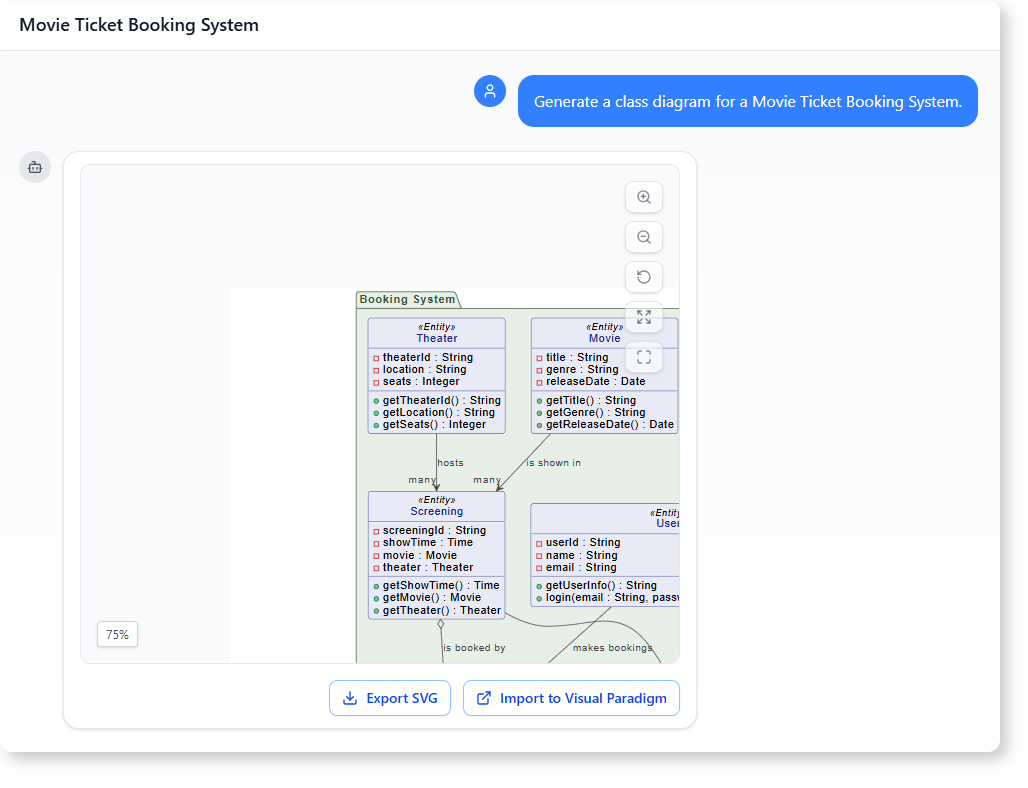Now Reading: How AI-Powered Modeling Software Builds a Movie Ticket Booking System Class Diagram
-
01
How AI-Powered Modeling Software Builds a Movie Ticket Booking System Class Diagram
How AI-Powered Modeling Software Builds a Movie Ticket Booking System Class Diagram
How AI-Powered Modeling Software Builds a Movie Ticket Booking System Class Diagram
Imagine you’re building a movie ticket booking app. You need to map out the core entities—movies, theaters, users, bookings—without spending hours writing code or manually sketching relationships.
That’s exactly what one developer did using AI-powered modeling software. They asked for a class diagram for a Movie Ticket Booking System and received a clear, structured, and fully contextual breakdown of how each component fits together.
This isn’t just a diagram. It’s a living model of the system’s logic, relationships, and data flow—created in minutes.

The User’s Journey: From Prompt to Diagram
The user was building a new software feature for a movie booking platform. They needed a clear class structure to guide development and ensure all key components were accounted for.
Instead of starting with a blank canvas or relying on team meetings to define the model, they used an AI-powered modeling software to generate a class diagram in one go.
Here’s how it unfolded:
Step 1: Define the System Scope
The user began by asking:
“Generate a class diagram for a Movie Ticket Booking System.”
This prompt was simple but powerful. It clearly defined the domain and the need for a visual model showing key entities and their relationships.
The AI interpreted this as a request to build a high-level class diagram centered on the core operations of a ticket booking system.
Step 2: Request a High-Level System Overview
After reviewing the initial diagram, the user followed up with:
“Provide a high-level description of the entities and how they form a complete system.”
The AI responded with a clear, structured breakdown of the system’s entities, their attributes, and how they interact.
This wasn’t just a list. It explained the role of each entity in the workflow and how they connect logically—like how a user makes a booking, how a screening ties movies and theaters, and how payments are linked to bookings.
What the AI-Powered Modeling Software Delivered
The result wasn’t just a picture of classes. It was a rich, information-packed model that explained:
- Core Entities: User, Movie, Theater, Screening, Booking, Ticket, Payment
- Data Attributes: Each class clearly shows what data it holds (like title, seat number, show time)
- Relationships: The software accurately captured dependencies, compositions, and aggregations
- System Flow: How the system moves from user input to final booking
For example:
- A user makes bookings for a screening
- Each booking contains one or more tickets
- The booking references a payment
- A screening is hosted by a theater and features a movie
- The system supports different types of users, including admins
The diagram used consistent styling—clean borders, readable fonts, and intuitive colors—to make the model easy to scan and understand.
Why This Is a Powerful Use Case for AI-Powered Modeling Software
Traditional UML tools require manual entry of every class and relationship. This can lead to errors, missed dependencies, or incomplete models.
With AI-powered modeling software, the process shifts from effort to insight.
This software doesn’t just generate a diagram. It creates a working mental map of the system—helping developers, product managers, and stakeholders understand how the components fit together.
The AI interprets natural language prompts and translates them into structured models. It understands domain context and builds meaning from the user’s intent.
This is especially useful in early-stage system design when the full scope isn’t yet clear.
How It Differs from Other UML Tools
| Feature | Traditional UML Tool | AI-Powered Modeling Software |
|——–|———————-|——————————|
| Prompt Input | Requires manual class creation | Ask for a system description in plain language |
| Diagram Generation | Manual drawing, time-intensive | Instant, accurate class diagram from a prompt |
| System Understanding | Limited to user input | Interprets relationships and roles automatically |
| Clarity of Output | Often ambiguous or incomplete | Clear, well-structured, and context-rich |
This isn’t a replacement for expert modeling. It’s a smart assistant that helps teams get to the right model faster.
Real-World Value in Practice
A developer working on a movie ticket app used this approach to:
- Avoid design errors by seeing all entity interactions at a glance
- Quickly communicate system structure to a non-technical stakeholder
- Identify missing relationships (like payment dependency)
- Build confidence in the system’s data model before coding began
The AI didn’t guess. It built a logical, realistic, and complete model based on real-world business rules.
FAQs
Q: Can AI-powered modeling software generate a class diagram for a Movie Ticket Booking System?
A: Yes. By describing the system in natural language, users can get a fully formed class diagram with entities, attributes, and relationships.
Q: What kind of relationships does the AI model in a class diagram?
A: The AI captures common relationships such as inheritance, composition, aggregation, and dependency, showing how classes interact in a real system.
Q: Is the generated diagram detailed enough for development?
A: Yes. The diagram includes attributes, operations, and relationships that help developers understand data flow and object responsibilities.
Q: How does the AI know which classes to include?
A: It analyzes the prompt and interprets the system’s core components. It adds logical entities like payment and tickets based on typical system behavior.
Ready to map out your system’s interactions? Give our AI-powered modeling software a try at Visual Paradigm’s AI Chatbot today!.
